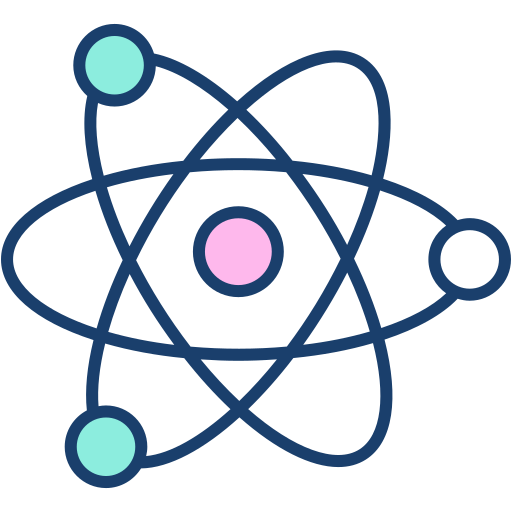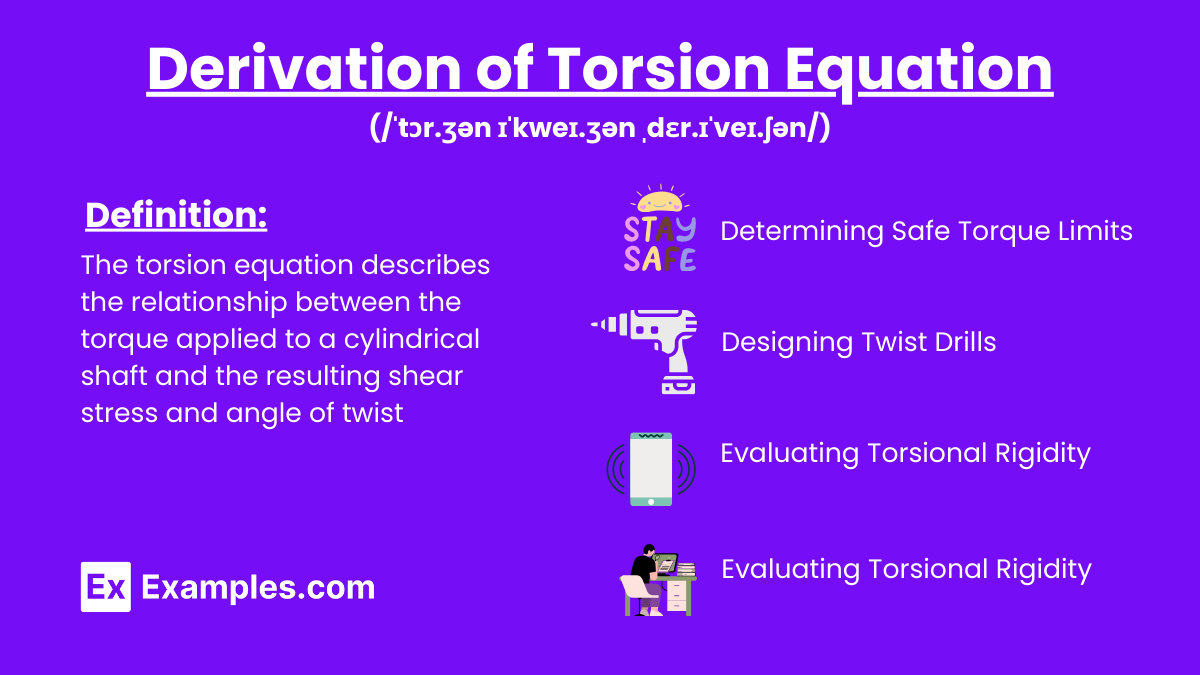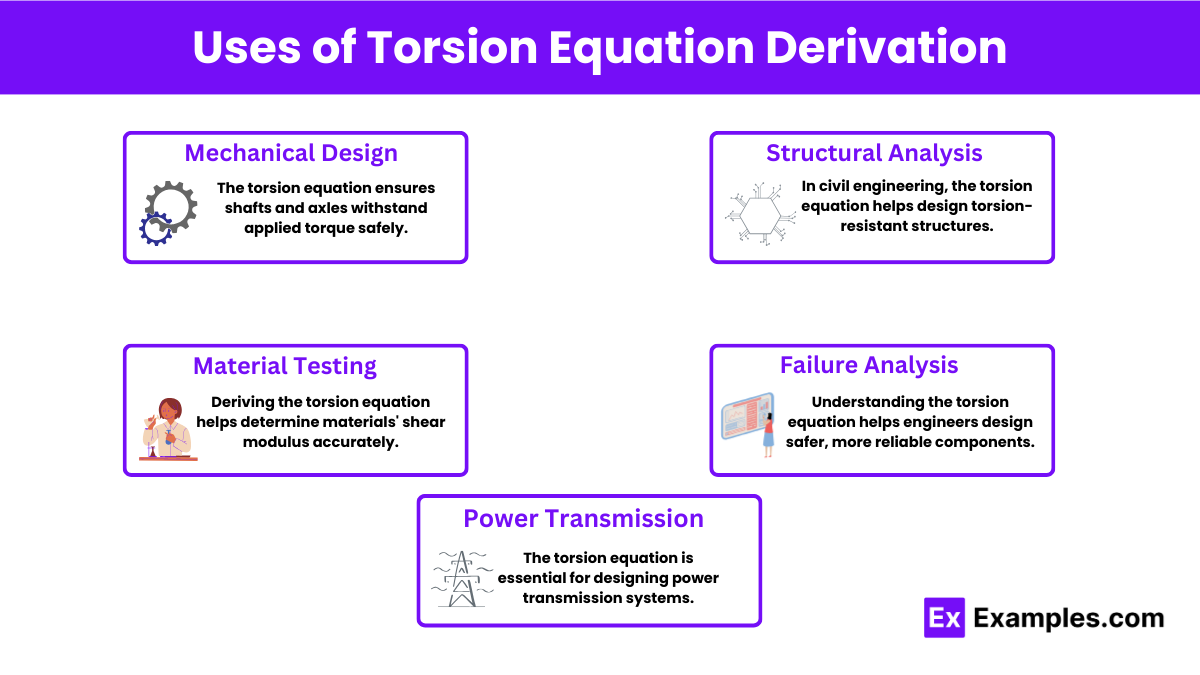What does r represent in the torsion equation T/J = τ/r = Gθ/L?
Length of the shaft
Radius of the shaft
Angle of twist
Shear modulus


The derivation of the torsion equation is a fundamental concept in the study of mechanical engineering and materials science. It describes the relationship between the torque applied to a cylindrical shaft and the resulting shear stress and angle of twist along its length. The equation is derived from the principles of equilibrium, compatibility, and material behavior, typically using polar coordinates. This derivation helps in understanding how shafts transmit mechanical power in machines, ensuring their design can withstand applied loads without failure, which is critical for the safety and efficiency of mechanical systems.
The torsion equation describes the relationship between the applied torque (T), the polar moment of inertia (J), the shear stress (τ), the radius of the shaft (r), and the angle of twist (θ) per unit length (L) in a cylindrical shaft. Here’s a step-by-step derivation of the torsion equation:
Polar Moment of Inertia (J):
The polar moment of inertia for a circular shaft of radius r is given by:
J = πr⁴/2
Shear Strain (γ):
Consider a shaft of length 𝐿L subjected to a torque 𝑇T. The shear strain 𝛾γ at a radius 𝑟r is given by the angle of twist per unit length 𝜃𝐿
γ= r ⋅ θ/L
Shear Stress (τ):
According to Hooke’s law for shear, shear stress τ is proportional to shear strain γ:
τ = Gγ = G ( r ⋅ θ/L )
Infinitesimal Torque (dT):
dT = τ ⋅ r ⋅ dA
Total Torque (T):
Integrate 𝑑𝑇 over the entire cross-sectional area to get the total torque:
T = ∫A τ ⋅ r ⋅ dA
𝑇 = ∫𝐴 ( 𝐺 ⋅ 𝑟 ⋅ 𝜃/𝐿)⋅𝑟⋅𝑑𝐴
𝑇 = Gθ/L ∫𝐴 r²dA
𝑇 = 𝐴 r²dA = J
𝑇 = GθJ/L
Torsion Equation:
Rearranging the above equation gives the torsion equation:
T/J = Gθ/L = τ/r
Torsion refers to the twisting of an object due to an applied torque or rotational force. This type of deformation occurs when a moment or couple is applied to a structural member, such as a shaft, causing it to twist around its longitudinal axis. In mechanical and structural engineering, torsion is a critical consideration for the design and analysis of components like drive shafts, axles, and beams subjected to twisting loads.
Key points about torsion:
The torsion equation, which relates these factors, is crucial for ensuring that components can withstand the applied loads without failure.
The torsion constant, denoted as ( J ), measures a cross-section’s resistance to twisting or torsion. For circular shafts, it equals the polar moment of inertia, ( J=2πr⁴/2 ), where ( r ) is the radius. For non-circular sections, ( J ) varies based on shape and dimensions. It influences the relationship between applied torque, shear stress, angle of twist, shear modulus, and length in the torsion equation: (T/J) =Gθ/L = τ/r. The torsion constant is crucial for assessing torsional strength and rigidity in structural and mechanical components.
Torque (T): The twisting force applied to an object in torsion analysis is measured in Newton-meters (N·m) in the SI system and Pound-feet (lb·ft) in the Imperial system.
Angle of Twist (θ): The angle of twist measures rotational deformation, typically in radians (rad) in the SI system, though degrees (°) can also be used for some applications.
Shear Stress (τ): The internal stress resulting from applied torque is measured in Pascals (Pa) or Newtons per square meter (N/m²) in the SI system, and in Pounds per square inch (psi) in the Imperial system.
Polar Moment of Inertia (J): This geometric property of the cross-section is measured in meters to the fourth power (m⁴) in the SI system and in inches to the fourth power (in⁴) in the Imperial system.
Shear Modulus (G): The shear modulus, relating shear stress to shear strain, is measured in Pascals (Pa) or Newtons per square meter (N/m²) in the SI system, and in Pounds per square inch (psi) in the Imperial system.
The moment of resistance is a crucial concept in structural engineering and mechanics, representing the capacity of a structural member to withstand bending moments. It is the internal moment that balances the external applied moment, ensuring the structure remains stable and does not fail under load.
Definition: The moment of resistance is the moment generated by internal stresses within a structural member, such as a beam or column, that opposes the applied bending moment. It is crucial for maintaining equilibrium and preventing structural failure.
Calculation: The moment of resistance is calculated using the formula:
Mᵣ = f⋅Z
where ( M_R ) is the moment of resistance, ( f ) is the allowable stress (such as yield stress for ductile materials or ultimate stress for brittle materials), and ( Z ) is the section modulus, a geometric property of the cross-section.
Section Modulus (Z): The section modulus is defined as:
Z =I/Y
where ( I ) is the second moment of area (or moment of inertia) of the cross-section, and ( y ) is the distance from the neutral axis to the outermost fiber of the section.
Units: The moment of resistance is typically measured in Newton-meters (N·m) or Pound-feet (lb·ft), depending on the unit system used.
Understanding and calculating the moment of resistance is essential for designing safe and efficient structures, ensuring they can resist applied loads without excessive deformation or failure.

The derivation of the torsion equation is fundamental in several areas of engineering and materials science. Here are some key uses:
Mechanical Design: The torsion equation helps in designing shafts, axles, and other components subjected to torsional loads, ensuring they can withstand the applied torque without failure.
Material Testing: By deriving the torsion equation, engineers can determine the shear modulus of materials through torsion tests, which is essential for characterizing material properties.
Power Transmission: The torsion equation is critical in the analysis and design of power transmission systems, such as those in automotive drivetrains and industrial machinery, where shafts transmit rotational power.
Structural Analysis: In civil engineering, the torsion equation aids in analyzing and designing structural elements like beams and columns that may experience torsional effects due to asymmetric loading or complex geometries.
Failure Analysis: Understanding the torsion equation allows engineers to predict failure modes in components subjected to torsional loads, contributing to the development of safer and more reliable designs.
Determining Safe Torque Limits:
One practical application of the torsion equation is determining the safe torque limits for cylindrical shafts. By using the derived equation, engineers can calculate the maximum torque that a shaft can withstand before yielding or failing. For example, in designing a steel drive shaft, the torsion equation helps ascertain the maximum torque that can be applied without exceeding the material’s yield strength, ensuring the shaft’s durability and safety in operation.
Designing Twist Drills:
In manufacturing, the torsion equation is used to design twist drills. These tools must withstand high torsional loads while maintaining their structural integrity. By applying the torsion equation, engineers can optimize the drill’s diameter and material properties to resist twisting forces, preventing failure during drilling operations and enhancing the tool’s lifespan.
Analyzing Torsional Vibrations:
In rotating machinery, torsional vibrations can lead to mechanical failures. The torsion equation helps in analyzing these vibrations and designing components to mitigate them. For instance, in turbine shafts, the equation is used to determine natural frequencies and design damping systems, ensuring smooth operation and reducing the risk of fatigue failure.
Evaluating Torsional Rigidity:
The torsion equation is vital for evaluating the torsional rigidity of various structural elements. In aerospace engineering, for example, the equation helps assess the rigidity of aircraft wings and fuselage sections. By determining the angle of twist under specific loads, engineers can ensure that these components maintain their structural integrity under operational stresses.
Optimizing Material Selection:
In material science, the torsion equation assists in optimizing material selection for components subjected to torsional loads. For instance, in the design of a high-performance automotive axle, engineers use the equation to compare different materials, such as steel and aluminum, to find the best combination of strength, weight, and cost. This optimization ensures that the component performs reliably under torsional stress while meeting other design criteria.
Yes, but the calculation of the polar moment of inertia 𝐽J is more complex for non-circular cross-sections.
The radius determines the distribution of shear stress, with maximum stress occurring at the outer surface.
It aids in designing shafts and other components to ensure they can withstand applied torques without failure.
It ensures safe and efficient design of mechanical and structural components subjected to torsional loads.
It helps in designing shafts that efficiently transmit rotational power without excessive twist or failure.
It is used to determine the shear modulus of materials through torsion tests.
It involves relating torque to shear stress through equilibrium, compatibility, and material behavior principles.
Yes, it helps predict potential failure modes such as yielding or buckling under torsional loads.
Shear strain is the angular deformation per unit length due to applied torque.
Assumptions include homogeneous, isotropic material, plane cross-sections remaining plane, and small deformations.
Text prompt
Add Tone
10 Examples of Public speaking
20 Examples of Gas lighting
What does r represent in the torsion equation T/J = τ/r = Gθ/L?
Length of the shaft
Radius of the shaft
Angle of twist
Shear modulus
What is the basic form of the torsion equation for a circular shaft?
T/J = τ/r = Gθ/L
T/J = τ/L = Gθ/r
T/J = Gθ/r = τ/L
T/J = τ/θ = Gr/L
In the torsion equation T/J = τ/r = Gθ/L, what does T represent?
Shear stress
Torque
Polar moment of inertia
Shear modulus
What does J represent in the torsion equation?
Shear stress
Torque
Polar moment of inertia
Shear modulus
In the torsion equation, what does τ represent?
Shear stress
Torque
Polar moment of inertia
Shear modulus
In the torsion equation, what does G represent?
Length of the shaft
Radius of the shaft
Angle of twist
Shear modulus
What does θ represent in the torsion equation T/J = τ/r = Gθ/L?
Length of the shaft
Radius of the shaft
Angle of twist
Shear modulus
What does L represent in the torsion equation?
Length of the shaft
Radius of the shaft
Angle of twist
Shear modulus
Which of the following is the correct expression for polar moment of inertia (J) for a circular shaft with radius r?
πr³/2
πr⁴/2
πr⁴/4
πr⁵/4
How does increasing the radius of a shaft affect the polar moment of inertia (J)?
J increases
J decreases
J remains the same
J becomes zero
Before you leave, take our quick quiz to enhance your learning!

